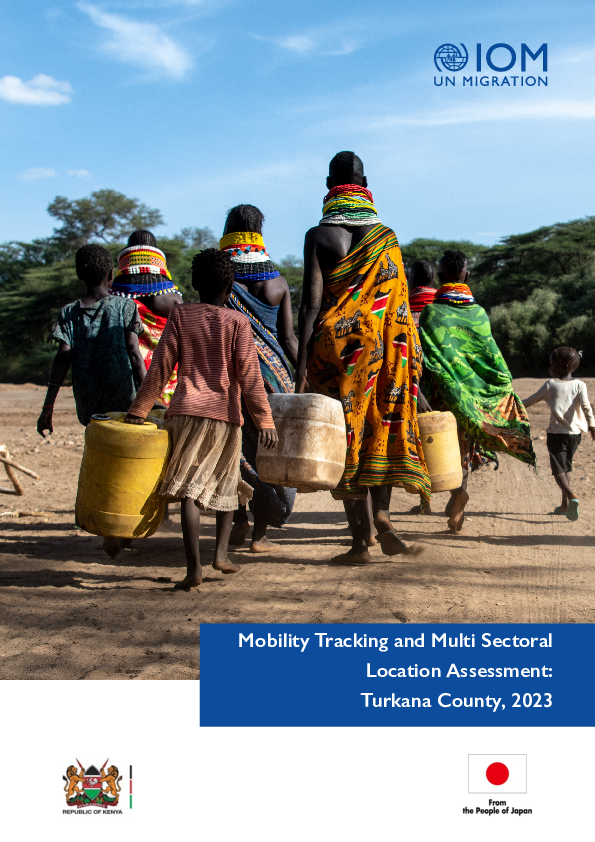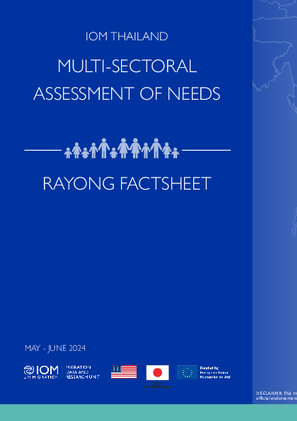-
Countries
-
Data and Analysis
-
Special Focus
-
Crisis Responses
Assessment Report

Contact
abate@iom.int
Language
English
Location
Saint Vincent and the Grenadines
Period Covered
Jul 15 2024
Jul 16 2024
Activity
- Survey
- Return Intention
- Mobility Tracking
- Site Assessment
On1 July 2024, Hurricane Beryl struck Saint Vincent and the Grenadines, causing widespread devastation, particularly on Union Island, Canouan, and Mayreau, where the entire population was affected. This report provides an overview of the situation in shelters following the hurricane, highlighting key sectors such as income, health, WASH, and protection services.
Key Data Highlights:
-
48 out of 60 respondents (81%) were not able to return to their house and 11 respondents (19%) were returning home.
-
Among those returning home, 7 out of 11 (64%) were moving with family, one respondent was moving with some of their family members and the remaining 3 were moving alone.
-
Out of those 48 respondents unable to return home:
-
77% intend to stay in their shelters (All persons who intended to stay in the shelters also reported this was because their homes were destroyed)
-
13% intend to relocate
-
10% intend to move with family
-
This summary includes insights into the vulnerabilities of shelter residents and their movement intentions, providing crucial information as the response phase transitions to early recovery. The data, collected from 15-16 July 2024, involved structured interviews conducted in various government shelters.

Contact
abate@iom.int
Language
English
Location
Saint Vincent and the Grenadines
Period Covered
Jul 03 2024
Jul 05 2024
Activity
- Site Assessment
Hurricane Beryl made landfall in Grenada and Saint Vincent and the Grenadines on the morning of 1 July 2024, before passing along the southwest of Jamaica between 2 and 3 July 2024. Extreme winds and storm surges in Grenada and St. Vincent and the Grenadines prompted a national level 1 emergency response with collaboration from the Caribbean Disaster Emergency Management Agency (CDEMA). This report provides profiles on shelter and NFI-related needs in assessed locations in Saint Vincent and the Grenadines and Grenada. As this was a rapid assessment, not all shelters could be covered, so these profiles serve as a baseline for displaced persons' locations post-Hurricane Beryl. Given the fluid situation and ongoing relief efforts, this report offers a snapshot of needs at the time of data collection.

Contact
DTM DRC, iomdrcdtm@iom.int
Language
French
Location
Democratic Republic of the Congo
Period Covered
Apr 09 2024
May 20 2024
Activity
- Mobility Tracking
- Baseline Assessment
Ce tableau de bord présente les principaux résultats de suivi des mouvements de populations dans la province du Tanganyika à l’issue du onzième round d’évaluation conduit par l’unité de la Matrice de Suivi des Déplacements (Displacement Tracking Matrix, en anglais (DTM)) de l’Organisation Internationale pour les Migrations (OIM). Ces évaluations ont été réalisées à travers un exercice de collecte de données conduit du 9 avril au 20 mai 2024, en collaboration avec l’ONG locale, Promotion de Développement Humain et Protection de l’Environnement Social (PDHPES), et la Division Provinciale des Affaires Humanitaires (DIVAH). Lors de ce cycle, un total de 5 027 villages, couvrant 11 zones de santé (ZS), ont été évalués à travers des consultations avec 14 261 informateurs clé.

Contact
iomkenyadru@iom.int
Language
English
Location
Kenya
Snapshot Date
Jul 30 2024
Activity
- Mobility Tracking
This report presents findings from the third round of Mobility Tracking. Mobility Tracking is a DTM methodology that aims to quantify the presence of population categories of interest, reasons for displacement, length of displacement and needs within defined geographical areas and locations, with a frequency that captures mobility dynamics.

Contact
DTM Europe, DTMMediterranean@iom.int
Language
English
Location
Bosnia & Herzegovina
Period Covered
Jun 01 2024
Jun 30 2024
Activity
- Flow Monitoring
This report provides insights into the profiles, experiences, needs, routes travelled and intentions of migrants transiting through Bosnia and Herzegovina (BiH). Data was collected from 1 to 30 June 2024. IOM carried out a route observation exercise in the Republika Srpska, Sarajevo Canton, Posavina Canton, Tuzla Canton, Bosnian-Podrinje Canton and Una Sana Canton to monitor trends in entries and exits as well as transit modalities within BiH. IOM also surveyed 49 migrants in active transit locations such as bus stops or at key entry and exit locations throughout the country as well as in four transit reception centres (TRCs) in BiH (Lipa, Ušivak, Borići and Blažuj).

Contact
iomnboim@iom.int
Language
English
Location
Kenya
Snapshot Date
Jul 30 2024
Activity
- Mobility Tracking
To assess drought-induced mobility and identify the most urgent sectoral needs experienced by the community, the IOM
Displacement Tracking Matrix (DTM) Mobility Tracking and Multi-Sectoral Location Assessment (MSLA) baseline assessment
was deployed in 2022 in Turkana County. A second round of data collection for mobility tracking took place between May
and June 2023, presented here. Key findings from this assessment included:
• Almost all arrival households (96% or 15,024 households) arrived at sub-locations in May 2023 that already
struggled with the severe effects of drought, resource-based conflict, and ethnic clashes.
• 78 per cent of returnees temporarily resided in Turkana in a location outside their immediate area of
origin, suggesting prevalent internal migration within the county.
• 19,515 child-headed households were identified. Of these, 1,622 (8%) had no relatives or community members
living near them and were separated from their legal or customary guardians.
• 6,216 children were without permanent sources of support.
• Almost half (48%) of the assessed sub-locations that reported loss of livestock reported child labour (whether
within or outside the ward) as a coping strategy, while around one quarter (24%) of sub-locations reported early
marriage of boys and girls as a key coping strategy.

Contact
DTM Europe, DTMMediterranean@iom.int
Language
Bosnian, Croatian, Serbian
Location
Serbia
Period Covered
Jun 01 2024
Jun 30 2024
Activity
- Survey
- Flow Monitoring
This report provides insights into the profiles, experiences and journeys of migrants transiting through the Republic of Serbia. Data was collected from 1 to 30 June 2024 together with the Commissariat for Refugees and Migration of the Republic of Serbia (SCRM). The sample consists of 151 interviewed migrants in Asylum Centres (AC) Sjenica, (AC) Tutin, (AC) Krnjaca, and Reception Centres (RC) Bujanovac, (RC) Presevo, and (RC) Pirot.

Contact
DTM Mediterranean, DTMMediterranean@iom.int
Language
English
Location
Serbia
Period Covered
Jun 01 2024
Jun 30 2024
Activity
- Survey
- Flow Monitoring
This report provides insights into the profiles, experiences and journeys of migrants transiting through the Republic of Serbia. Data was collected from 1 to 30 June 2024 together with the Commissariat for Refugees and Migration of the Republic of Serbia (SCRM). The sample consists of 151 interviewed migrants in Asylum Centres (AC) Sjenica, (AC) Tutin, (AC) Krnjaca, and Reception Centres (RC) Bujanovac, (RC) Presevo, and (RC) Pirot.

Contact
DTMThailand@iom.int
Language
English
Location
Thailand
Period Covered
May 18 2024
Jun 13 2024
Activity
- Survey
- Site Assessment
This factsheet aims to provide a snapshot of multi-sectoral conditions, needs, and challenges among Myanmar migrants in Surat Thani as captured between May and June 2023 by IOM Thailand’s multi-sectoral assessment of needs. The purpose of this assessment is to provide insights regarding the severity of needs among migrant populations, identify vulnerable population groups and geographic areas with the most acute needs, inform assistance planning and relevant Sustainable Development Goals (SDGs) targets, and provide sectoral and inter-sectoral baselines for future assessments.

Contact
DTMThailand@iom.int
Language
English
Location
Thailand
Period Covered
May 18 2024
Jun 01 2024
Activity
- Survey
- Site Assessment
This factsheet aims to provide a snapshot of multi-sectoral conditions, needs, and challenges among Myanmar migrants in Rayong as captured between May and June 2024 by IOM Thailand’s multi-sectoral assessment of needs. The purpose of this assessment is to provide insights regarding the severity of needs among migrant populations, identify vulnerable population groups and geographic areas with the most acute needs, inform assistance planning and relevant Sustainable Development Goals (SDGs) targets, and provide sectoral and inter-sectoral baselines for future assessments.
Pagination
- Previous page
- Page 17
- Next page
